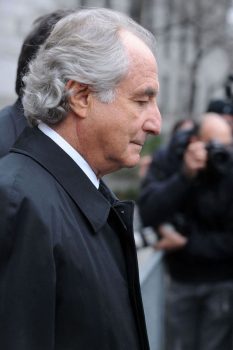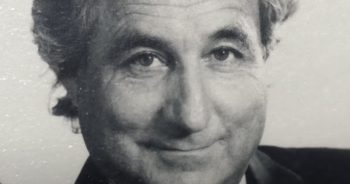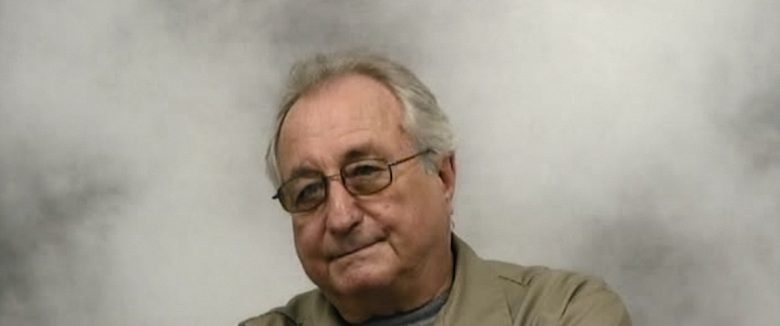Madoff: The Monster of Wall Street – Reviewed by MAUREEN MCCABE
Joe Berlinger has made a well-deserved name for himself with his admirable true crime documentaries and his Madoff: The Monster of Wall Street. currently on Netflix, is his latest in a line of compelling series he’s made for the streaming giant. Tracing Madoff’s rise from a small investment manager trading over the counter stocks to one of the most highly respected Wall Street brokers to disgraced ponzi schemer, it deftly lays out the extent of his fraud and how long he’d been perpetrating it. Almost from the very beginning, he had a secret investment management business that he didn’t register and didn’t run strictly by the rules for private clients alongside his legitimate stock trading business. Like his company, Madoff is portrayed as having a split personality: he cultivates an image of a kind, loving family man; employees praise him as a generous, genial boss; he was widely regarded as one of the most highly respected and influential figures on Wall Street. He also has a dark side that he shows occasionally: deceptive, bullying, and prone to anger. The opening scenes call him a “serial financial killer” and “a demon, a devil” who orchestrated one of the biggest criminal enterprises in Wall Street history.” And yet, in his is victim deposition from prison, when Madoff asks himself why he did what he did his answer is that he wanted to please people, and he wanted to be thought of as a success. Did he truly believe that or was he lying, like he’d spent much of his professional life doing? It’s impossible to say. This duality is part of what makes the docuseries so fascinating and if we never truly find out why Madoff did what he did, or how he thought it would all eventually play out, what we do find out during the course of the four episodes is riveting.
From his humble beginnings as the son of struggling Jewish immigrants, Madoff was determined to be a success. He began his legitimate stock trading business and despite some initial hiccups, he went on to earn a reputation as broker who could get above-average returns, often way above average. He was one of the earliest people to see the great potential in using computers in trading and was one of founders of the NASDAQ stock index. Despite all his success, he continued to run his secret consulting business, attracting many very wealthy clients including hedge funds and management corporations. He promised and supposedly delivered fantastic returns, but it was all a sham. The phony returns, printed on ancient-looking dot matrix paper, showed stocks bought and sold at great profits and were sent to investors who turned a blind eye to the eccentricities of their broker. But where some brokers might have sent out fake returns to cover poor trades, the difference with Madoff is that he never actually bought any stocks. Instead, he kept the money in a JP Morgan Chase account and used new investors’ money to pay off older ones

The docuseries relies on well-paced interviews with Madoff employees, journalists, Securities and Stock Exchange officials, and clips of Madoff himself from his criminal deposition to provide information and interest. In tried true crime documentary fashion, it also features many dramatic recreations. There are perhaps a few too many clips of Madoff look-alike Joseph Scotto expressionlessly chomping on huge cigars but some of the staged scenes are fascinating. The one where employees attempting to fool investigators throw print outs around the office to make them look used and then put the still warm-from- the-printer pages in the refrigerator to cool them off is especially striking. The docuseries is excellent at providing intimate details like this, while also explaining the complex scope of Madoff’s crime in a coherent, easily digestible fashion.
Perhaps the most maddening aspect of the Madoff saga is that he actually never was caught. The SEC had several opportunities to stop him. A portfolio manager named Harry Markopolos was tasked by his bosses at another investment company to duplicate Madoff’s results. Looking at a single page of Madoff’s supposed returns, it took Markopolos less than five minutes to conclude that they were fraudulent. He spent eight years notifying the SEC in specific, detailed, well-reasoned fashion of all the red flags surrounding Madoff’s investment group. As he said, he’d handed Madoff to the SEC “on a silver platter.” He was not the only one who alerted them about discrepancies they found in Madoff’s returns either; others who found his astronomical rate of profits mathematically impossible tried to warn them: like him they too were dismissed.
When the SEC finally did decide to investigate, they sent in two junior investigators, fresh out of school, who were cowed by the mighty and well-respected Madoff, who, according to emails from their boss, might soon be running the SEC. Other, equally inept, investigations followed but were never followed through on. The fact that there was never any fraud exposed allowed Madoff to attract even more clients, who erroneously believed the lack of findings proved he was completely above board. If it wasn’t for the 2008 financial crisis, Madoff might never have been exposed and he might have continued ripping people off for years longer. Markopolos said that when he first notified the SEC of Madoff’s the amount of the was 6 billion, by the time the market collapsed in 2008 it was over 64 billion.
Most movingly, the series documents the horrible toll the case took on its victims. Many extremely wealthy and famous people lost money with Madoff, and pensions, non-profits, and companies were ruined. But many of Madoff’s victims were regular folk, people who had sold their mom- and- pop stores, and invested all the proceeds to fund their futures, retirees who lost their homes and life savings, elderly Jewish people, many of them widows, who felt a kinship with Madoff, giving him all their families money and who were among his earliest and most betrayed clients. Madoff’s family also suffers, especially his sons, who turned him in to the FBI when they became aware of what he was doing. The older one dies by suicide, the other dies of reoccurrence of cancer which he blames on the stress of his father’s crime. Madoff’s wife is left basically homeless.

But the other big players in the Madoff scheme go unpunished. As the final episode details, while several of his employees are sentenced to prison, none of the hedge fund managers and investment companies CEO’s who supplied Madoff with capitol went to jail. Only one bank, JP Morgan Chase, where Madoff kept his account, was even fined, but considering how long he was a client and how much money they made, it was most likely a slap on the wrist. The regulatory agencies and the SEC, who were charged with preventing the type of crime that Madoff perpetrated were never held accountable. That might be Berlinger’s greatest strength as a documentarian: his ability to raise our compassion and our ire at the same time. While much of the information he provides isn’t new, it is presented in an engrossing, comprehensible, format. You don’t have to play the stock market, or have a degree in finance to be engaged and angered anew by Madoff: The Monster of Wall Street.
– Reviewed by MAUREEN MCCABE







